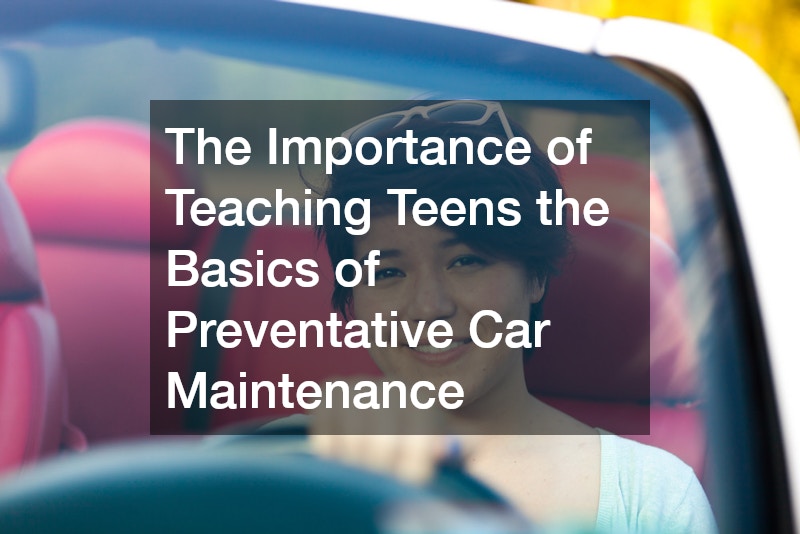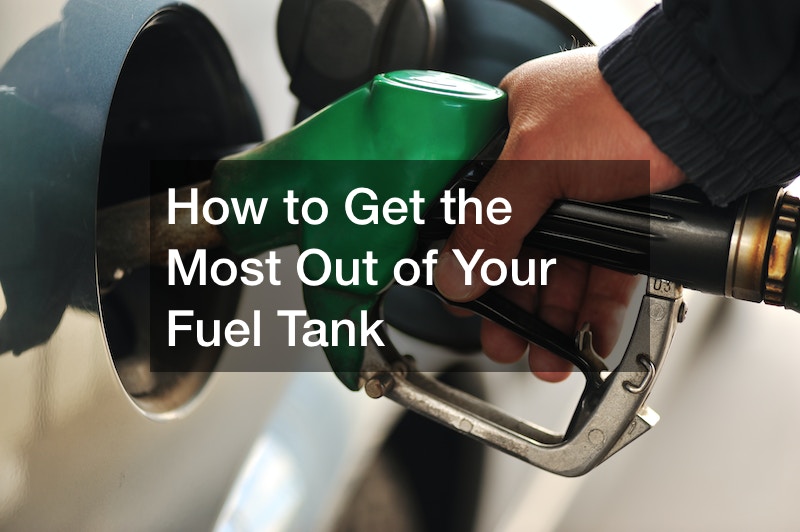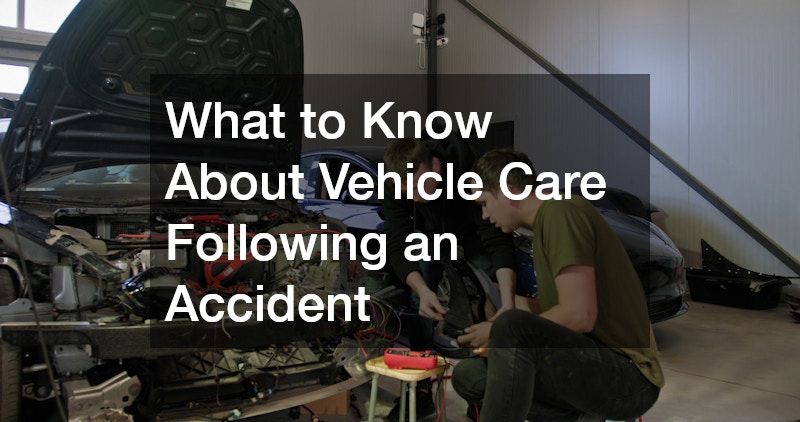
What to Know About Vehicle Care Following an Accident

Experiencing a vehicle accident can be stressful and overwhelming, no matter how minor or severe the damage may seem. In the aftermath, it’s important to take a structured and informed approach to caring for your vehicle. Proper post-accident attention ensures your car not only looks as good as it did before the incident but also remains safe and reliable on the road. Many drivers make the mistake of focusing only on surface-level issues without realizing that deeper mechanical or structural damage can affect long-term performance and safety.
Assessing the Condition of Your Vehicle After a Collision
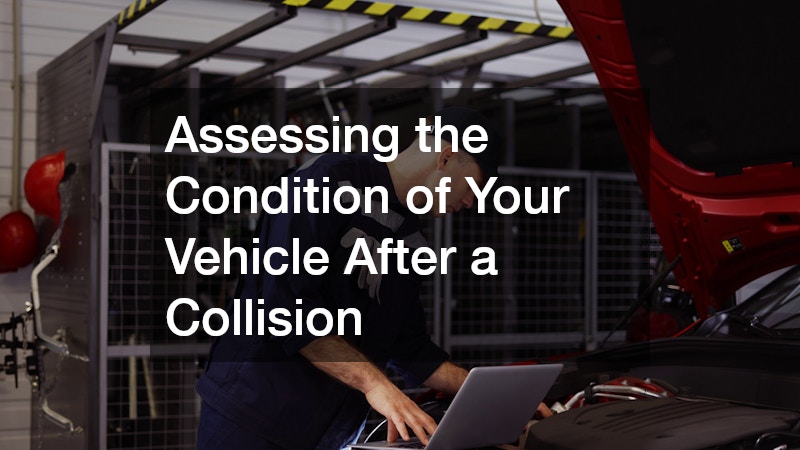
After a collision, the first and most essential step is to assess the full extent of your vehicle’s condition. Even minor fender benders can cause hidden issues that aren’t immediately visible to the untrained eye. A professional evaluation helps determine whether the frame has been bent, if alignment has shifted, or if safety systems like airbags have been compromised. This inspection ensures that both visible and internal damage are identified before any major repairs begin. It also prevents the risk of operating a vehicle that may no longer meet safety requirements.
When it comes to a thorough inspection, seeking out an experienced auto repair professional is key. They have the diagnostic tools and expertise to uncover structural, electrical, and mechanical issues that often go unnoticed. An inspection typically includes checking suspension alignment, ensuring that the wheels rotate properly, and scanning for computer system alerts. Addressing these problems early can prevent further deterioration and costly fixes down the line, ensuring your vehicle’s performance and safety remain intact.
Beyond mechanical diagnostics, a full assessment also includes reviewing the vehicle’s safety systems and overall functionality. Professionals often check the integrity of seat belts, airbags, and electronic sensors to ensure they’re still in proper working condition. They may also analyze fluid levels, battery output, and electronic control systems that may have been disrupted by the impact. By ensuring every detail is examined, you’ll know exactly what needs attention before returning your car to regular use.
Knowing When to Replace Worn or Damaged Tires
Tires are one of the most important safety components of any vehicle, and after an accident, they can easily become compromised. A sudden impact can cause unseen structural damage to the sidewalls or internal belts, even if the tire appears fine externally. Continuing to drive on damaged tires can lead to uneven wear, reduced traction, and a higher risk of blowouts. Checking for cracks, bulges, or unusual vibration while driving helps determine whether tire replacement is necessary.
If the inspection shows signs of damage, replacing the affected tires with new tires is a wise investment in safety and performance. A professional technician can measure tread depth, inspect for punctures, and assess whether all tires need to be replaced or just a select few. In many cases, replacing them in pairs or sets ensures even wear and balanced handling. This proactive approach not only restores smooth driving but also improves fuel efficiency and braking response, which are critical after your vehicle has been through an impact.
It’s also important to ensure that your new set of tires is compatible with your vehicle’s specifications. Tire professionals can recommend the correct size, speed rating, and tread pattern to match your driving needs. Additionally, they’ll verify that the wheels and suspension components weren’t damaged during the collision, as this can affect tire alignment and lifespan. Investing in quality replacements now helps prevent recurring tire issues and improves your car’s overall driving stability.
Understanding the Importance of Timely Tire Repairs
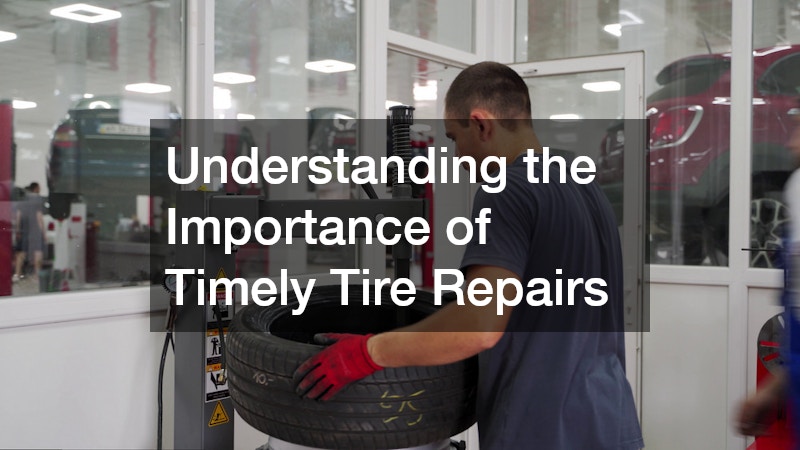
In some situations, tire issues after a collision don’t require full replacement but instead need prompt attention to minor damage. Punctures or small leaks can quickly worsen if left unattended, leading to sudden deflation or unsafe driving conditions. A timely response ensures that small, manageable problems don’t turn into major hazards later on. Maintaining tire integrity also helps preserve overall vehicle balance, which is especially important after structural adjustments or suspension repairs.
When you visit a shop for tire repairs, technicians can determine if a simple patch or plug will restore the tire’s condition. They’ll evaluate the puncture’s size, location, and angle to confirm that it can be safely repaired without compromising the tire’s performance. Using professional-grade equipment ensures that the repair meets industry safety standards. Proper tire maintenance following an accident supports consistent handling and minimizes the likelihood of uneven tread wear caused by impact-related misalignment.
A professional tire repair also includes checking for hidden structural issues that could cause long-term problems. Some damage may not be visible from the outside but could weaken the tire from within. A full inspection ensures you won’t experience a blowout or slow leak later on. By addressing small issues right away, you maintain your vehicle’s stability and safety while extending the lifespan of your existing tires.
Handling Cracked or Shattered Windows and Windshields
A collision can often result in damaged glass, whether it’s a small crack in the windshield or shattered side windows. Even a tiny chip can grow into a major fracture due to temperature changes or road vibrations. Ignoring these issues can obstruct your view and increase the risk of further damage during everyday driving. Beyond aesthetics, maintaining clear and intact glass is critical for your vehicle’s structural integrity and safety during another impact.
Professional auto glass replacement ensures that your vehicle’s windows and windshields are restored to factory standards. Technicians use specialized adhesives and precision tools to securely install new glass, preventing leaks and maintaining airbag deployment functionality. Modern glass replacements often include advanced driver assistance system (ADAS) recalibration, which ensures sensors and cameras function correctly. This process restores not only visibility and comfort but also the full protective capacity of your vehicle’s design.
Additionally, replacing damaged glass improves insulation and reduces noise within the cabin. Cracked glass can allow drafts, moisture, and road noise to enter, making driving less comfortable. High-quality replacement glass restores your vehicle’s appearance and functionality while reinforcing its safety systems. By addressing glass damage immediately, you preserve both your safety and the overall integrity of your car.
Choosing the Right Facility for Collision Restoration
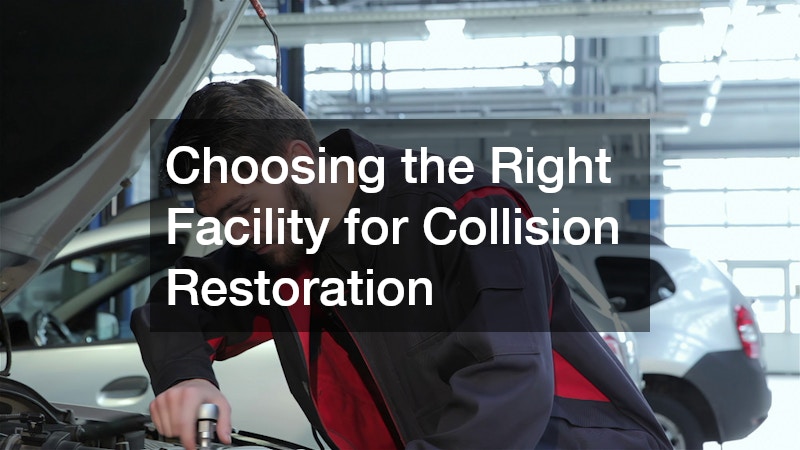
Finding a reliable facility to handle post-accident restoration can make a significant difference in the outcome of your repairs. A high-quality repair center will prioritize both the appearance and safety of your vehicle, using certified parts and following manufacturer guidelines. The best facilities employ trained technicians who understand the latest diagnostic technologies and safety standards. Choosing the right professionals helps guarantee that your vehicle receives precise and lasting repairs.
An experienced auto body shop can repair dents, fix structural damage, and repaint your vehicle to match its original finish. Many reputable shops offer lifetime warranties on their work, giving you confidence in the quality of the restoration. They may also work directly with insurance providers to simplify the claims process. By selecting a shop that values craftsmanship and clear communication, you can ensure your vehicle looks and performs just as well as it did before the collision.
Before selecting a repair facility, it’s wise to read reviews, request estimates, and verify certifications such as I-CAR or ASE. These credentials show that technicians are trained in current repair standards. Additionally, a transparent estimate process and clear communication throughout repairs help you stay informed and avoid unexpected costs. Doing a little research upfront ensures that your car receives professional, long-lasting restoration.
Exploring Comprehensive Restoration and Refinishing Options
When a vehicle sustains body damage, restoring it to its pre-accident condition often requires multiple specialized services. Comprehensive restoration involves more than just repairing dents and scratches—it includes aligning panels, repainting, and addressing structural or cosmetic imperfections. Proper refinishing enhances not only the vehicle’s appearance but also its resale value and corrosion resistance. Professional restoration should prioritize both function and aesthetics to ensure lasting results.
Certified technicians offering auto body services will carefully match your car’s original paint color and texture, blending new sections seamlessly with existing panels. They can also correct frame misalignment, repair damaged bumpers, and remove imperfections caused by debris. Many modern facilities use eco-friendly paint and coating systems to reduce environmental impact while achieving a flawless finish. The goal is to make your vehicle look as though it never experienced damage while maintaining its structural reliability.
Recognizing Signs of Engine Trouble After an Impact
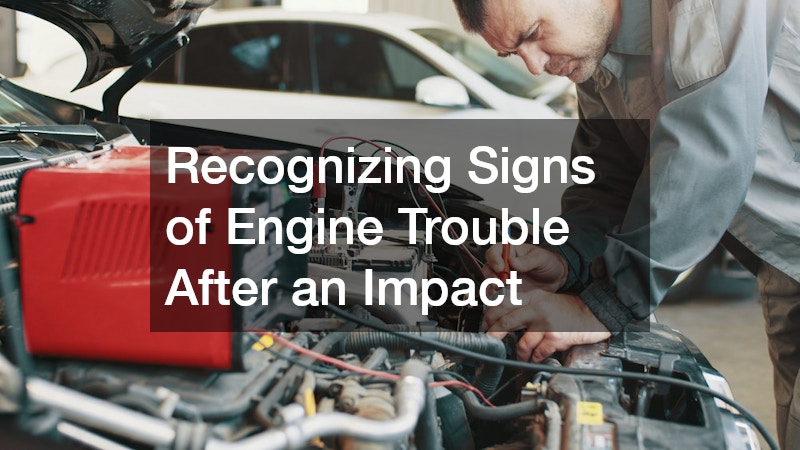
While visible body damage often takes center stage after an accident, internal components like the engine can also be affected. Even a minor collision can cause mechanical misalignment, oil leaks, or timing issues that disrupt your vehicle’s performance. Warning lights, unusual noises, or difficulty starting the engine can all signal deeper mechanical damage. Early diagnosis prevents small engine issues from escalating into major, costly repairs later.
If a technician detects internal damage related to the vehicle’s timing or synchronization, timing belt repair may be necessary. This component ensures that the engine’s valves and pistons move in perfect coordination, and even slight misalignment can lead to poor performance or engine failure. Replacing or repairing the belt after an accident ensures smooth operation and prevents additional stress on the engine. Professional service helps verify that all related components, such as tensioners and pulleys, are in proper working condition before you resume regular driving.
Ensuring Reliable Stopping Power for Safe Driving
Your vehicle’s braking system is one of the most critical elements for post-accident safety. Sudden impacts can alter brake alignment, cause fluid leaks, or damage sensitive components like rotors or calipers. Even if the brakes feel normal, hidden issues could lead to reduced stopping power or uneven performance. Testing your brakes after a collision is essential to maintaining full control and ensuring road safety in all conditions.
A thorough brake service performed by a certified mechanic includes inspecting pads, rotors, fluid levels, and hydraulic lines. Technicians can identify signs of wear or imbalance that may have resulted from the accident. Replacing worn components or flushing the brake fluid ensures consistent, reliable braking performance. Regular maintenance after an accident can also improve responsiveness and prevent premature wear on related systems, giving you confidence behind the wheel.
Caring for Imported Vehicles After a Crash
Foreign-made vehicles often feature specialized components and systems that require expert attention following an accident. Because these vehicles may use unique parts or configurations, not every repair facility has the knowledge or tools to work on them properly. Failing to use the correct replacement parts or repair procedures can affect performance, efficiency, and warranty coverage. It’s important to choose professionals experienced with the specific brand and model of your imported car.
Specialized foreign car repair services provide the technical expertise needed to restore imported vehicles to manufacturer standards. These technicians understand intricate systems such as turbochargers, advanced electronics, and adaptive suspensions that may differ from domestic vehicles. They use manufacturer-approved diagnostic software and genuine replacement parts to ensure precision and reliability. Whether your vehicle is European, Japanese, or another import, expert attention ensures it remains in peak condition after a collision.
Seeking Legal Guidance for Accident-Related Claims
Dealing with the aftermath of a collision often extends beyond physical repairs and can involve complex insurance or legal matters. Understanding your rights and responsibilities is crucial when negotiating claims or seeking compensation for damages. A legal professional can help you navigate confusing paperwork, communicate with insurers, and ensure that your interests are fully protected. Their support can make the difference between a smooth resolution and a stressful process.
Working with an experienced auto accident lawyer can provide valuable guidance on filing claims, recovering losses, and handling liability disputes. They can gather evidence, assess the value of your claim, and negotiate with insurance providers to achieve a fair outcome. In cases involving injury or significant property damage, legal expertise ensures that you understand all available options for recovery. Having a professional advocate on your side allows you to focus on restoring your vehicle and returning to normal life.
Taking care of your vehicle after an accident is about more than restoring its appearance—it’s about preserving safety, performance, and peace of mind. Each component, from the tires and brakes to the body panels and glass, plays a vital role in your vehicle’s overall reliability. Overlooking even small issues can lead to future complications, so investing in a detailed inspection and professional auto repair is always worthwhile.
